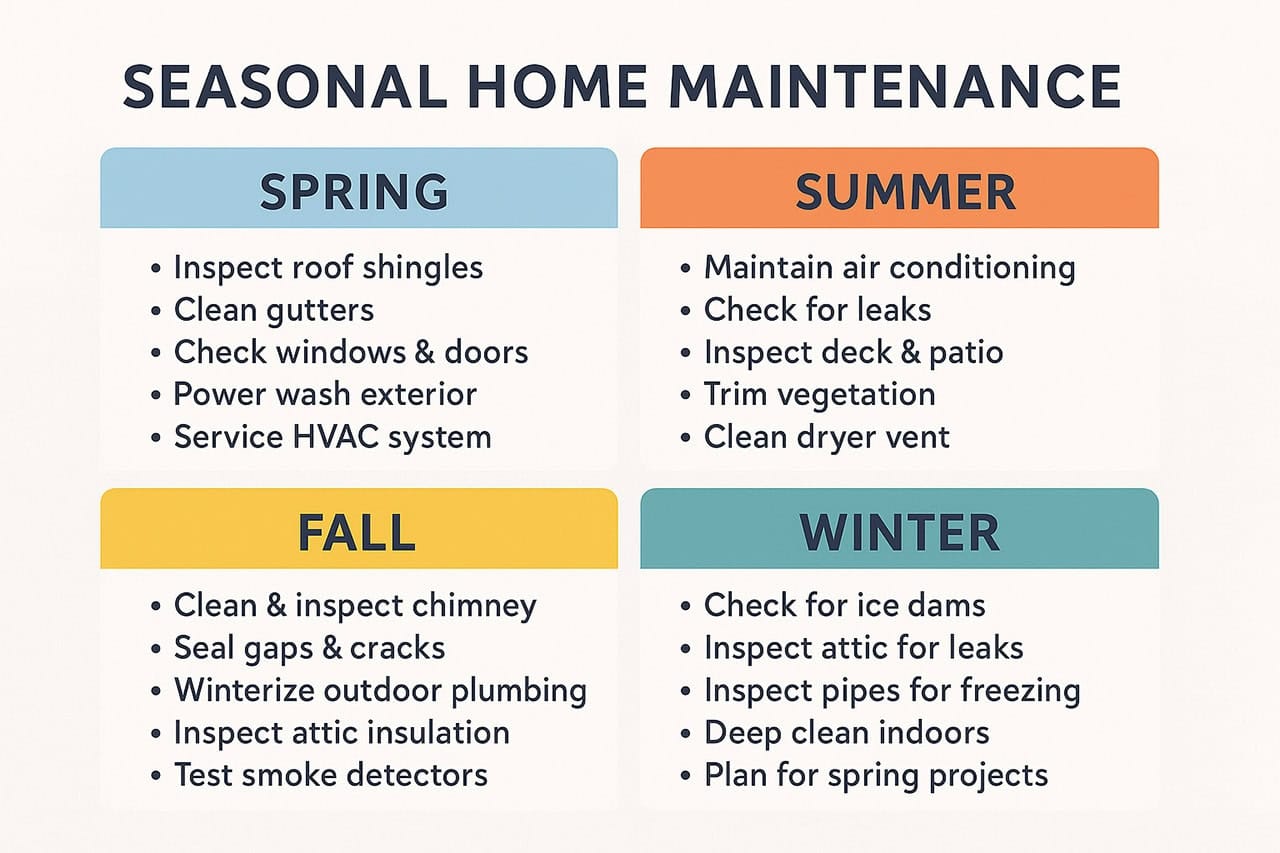The Ultimate Seasonal Home Maintenance Checklist
Keeping up with home maintenance can feel overwhelming, especially when tasks pile up throughout the year. The secret isn’t doing everything at once – it’s creating a systematic approach that breaks maintenance into manageable seasonal chunks. A well-organized seasonal checklist ensures nothing gets forgotten while preventing small issues from becoming expensive repairs.
Why Seasonal Maintenance Matters
Most homeowners wait until something breaks before taking action. This reactive approach often leads to:
- Higher repair costs
- Inconvenient timing for repairs
- Potential safety hazards
- Reduced property value
A proactive seasonal approach helps you catch problems early, extends the life of your home’s systems, and gives you control over when and how maintenance gets done.

Spring: Awakening Your Home
Exterior Focus:
- Inspect roof shingles for winter damage
- Clean and repair gutters and downspouts
- Check exterior caulking around windows and doors
- Test outdoor water spigots and irrigation systems
- Power wash decks, patios, and exterior surfaces
- Inspect and clean outdoor lighting fixtures
Interior Tasks:
- Replace HVAC filters and schedule system tune-up
- Test smoke and carbon monoxide detectors
- Deep clean carpets and upholstery
- Inspect plumbing for leaks or water damage
- Check attic and basement for pest activity
- Service garage door mechanisms
Garden and Landscape:
- Prune trees and shrubs
- Fertilize lawn and garden beds
- Check and repair fencing
- Clean and organize outdoor storage areas
Summer: Maintenance in Full Swing
Cooling System Care:
- Clean air conditioning units and replace filters monthly
- Check refrigerator coils and clean if needed
- Inspect window and door seals for energy efficiency
- Test attic ventilation and fans
Outdoor Maintenance:
- Inspect and seal deck staining or painting
- Clean and maintain outdoor furniture
- Check pool equipment if applicable
- Trim vegetation away from house foundation
- Monitor irrigation systems for efficiency
- Inspect and clean barbecue grills
General Upkeep:
- Check caulking in bathrooms and kitchens
- Inspect basement for moisture issues
- Clean dryer vents thoroughly
- Test electrical outlets and GFCI switches
Fall: Preparing for Winter
Weatherization Priority:
- Winterize outdoor water systems
- Clean and inspect chimney and fireplace
- Seal gaps and cracks in exterior walls
- Install storm windows or check existing seals
- Clean gutters one final time before leaf season ends
- Drain and store garden hoses
Heating System Prep:
- Replace furnace filters
- Schedule professional heating system inspection
- Test all heating zones and thermostats
- Check insulation in attic and basement
- Reverse ceiling fan directions for winter circulation
Safety and Security:
- Test and replace batteries in smoke detectors
- Inspect and clean emergency flashlights
- Check that emergency kits are well-stocked
- Trim tree branches that could fall on house
- Secure or store outdoor furniture and decorations
Winter: Indoor Focus and Planning
Interior Maintenance:
- Monitor humidity levels and use humidifiers if needed
- Check for ice dams on roof and gutters
- Inspect pipes in unheated areas for freezing risk
- Deep clean and organize storage areas
- Service indoor air quality systems
- Check and touch up interior paint
Planning Phase:
- Review this year’s maintenance record
- Plan major projects for upcoming year
- Research contractors for bigger jobs
- Order supplies for spring projects
- Update insurance documentation
- Create next year’s maintenance budget
Creating Your Personal Checklist
Step 1: Assess Your Home’s Unique Needs
Every home is different. Consider:
- Age of your home and its systems
- Local climate challenges
- Previous problem areas
- Manufacturer warranties and service requirements
Step 2: Prioritize by Impact and Urgency
Not all tasks are equally important. Rank items by:
- Safety concerns (highest priority)
- Potential for expensive damage
- Energy efficiency impact
- Cosmetic improvements (lowest priority)
Step 3: Set Realistic Timeframes
Don’t overload any single season. Spread tasks throughout each season and consider:
- Your available time and skills
- Weather-dependent activities
- Professional service availability
Step 4: Create Accountability Systems
- Use a calendar app with reminders
- Keep a maintenance log
- Take before/after photos
- Track expenses for budgeting
Tools for Success
Essential Supplies to Keep Stocked:
- Basic tool kit (screwdrivers, hammer, pliers)
- Caulk gun and various caulks
- Weatherstripping materials
- Replacement air filters
- Flashlights and batteries
- Emergency repair supplies (duct tape, pipe repair kit)
Documentation Tools:
- Home maintenance binder or digital file
- Calendar with maintenance reminders
- Contact list for reliable contractors
- Warranty information for appliances and systems
Making It Sustainable
The best maintenance schedule is one you’ll actually follow. Here’s how to stick with it:
Start Small: Don’t try to implement everything at once. Pick 3-4 essential tasks per season and build from there.
Bundle Tasks: Group related activities together. For example, when you’re already in the attic checking insulation, also look for pest signs and test the ventilation fan.
Use Professional Help Strategically: Some tasks are worth outsourcing. Use professionals for complex systems while handling simpler tasks yourself.
Track Your Wins: Keep records of problems you prevented and money you saved. This motivation helps maintain the habit.
Red Flags That Need Immediate Attention
Some issues can’t wait for the scheduled season:
- Water leaks or stains
- Electrical problems or burning smells
- Unusual noises from major appliances
- Cracks in foundation or walls
- Pest infestations
- Any safety equipment failures
Conclusion
A seasonal maintenance approach transforms overwhelming home care into manageable, predictable tasks. By spreading work throughout the year and staying proactive, you’ll save money, prevent headaches, and maintain your home’s value.
Remember: the goal isn’t perfection but consistency. Even completing 80% of your seasonal checklist puts you far ahead of most homeowners and helps ensure your biggest investment stays in excellent condition year-round.
Start with the upcoming season and adjust your checklist based on what you learn about your home’s specific needs. Your future self will thank you for the peace of mind that comes with a well-maintained home.
